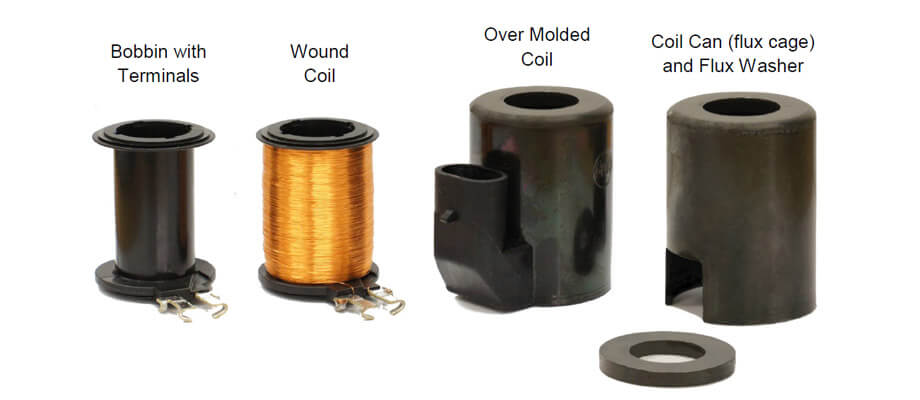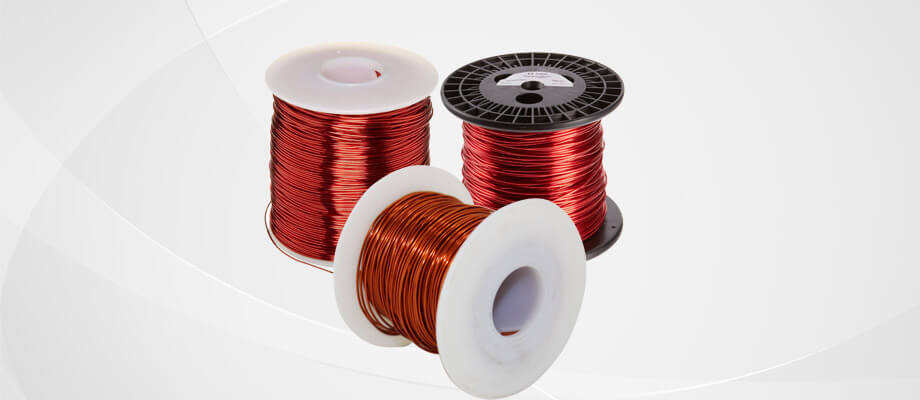A complete hydraulic solenoid is consist of solenoid coil and solenoid tube assembly. It is a basic electromagnetic actuator that converts the electrical signals into mechanical force, which triggers the valves to control the pressure or size and directions of flow.
In normal hydraulic solenoid market, the complete hydraulic solenoid assembly and solenoid coils can be sold both integrated or separately. The performance of hydraulic solenoid starts from the solenoid coil. Solenoid coils have multiple wraps of copper wire, when the valve turns on, the copper wires are electrified, which creates a magnetic field so the plunger in solenoid tube assembly moves and trigger the valves.
There are different types of hydraulic solenoids, the two main hydraulic solenoid types are on-off solenoid and proportional solenoid. These two types of hydraulic solenoid have different working methods. For proportional solenoids, there is a proportional amplifier connect with the solenoid which is used to control the power of proportional solenoid coil. Although on-off solenoid and proportional solenoid are different, the solenoid coils are the same.
To understand how the solenoid materials effect coil serve life, we have has a clear information about different parts of solenoid coils.
Solenoid Coil Assembly
To make a hydraulic solenoid coil, there also need several different components. The copper wires are the core part of a solenoid coil. The copper wires are winding on a bobbin, and there is circuit inside the bobbin, also, you can find the terminals on the bobbin. Some solenoids have open frames, so there are no other elements on the solenoid coils, and you can see the copper wires wide and clear. But hydraulic solenoids have been used in many different hydraulic equipment for industrial purposes, therefore, an open frame solenoid structure is too dangerous for hydraulic solenoids.
Normally, the solenoid coil for hydraulic solenoid is consist of copper wires, bobbin with terminals, and a coil can on the outside, but before the coil can has been installed, the wound coil must be over-molded. Each material for different solenoid coil parts must be considered during solenoid coil making process.

Solenoid Coil Wire Materials & Temperature Ratings
Solenoid coil is the most easy-damage part of the complete hydraulic solenoid. During hydraulic solenoid working process, the overheating problem may cause the solenoid coil burnt out. Therefore, the temperature ratings of solenoid coils are very important to the operation of hydraulic solenoid.
To enhance the temperature ratings of solenoid coils, the solenoid coil materials and power consumption are the most important factors.
Talking about the solenoid coil materials, the most important solenoid materials is the copper wires. There are many different grades of copper wires, and the different wire grades represent different melt temperatures. Normally, the qualified wire grades for solenoid coil is class f and class h. Class f copper wire is the basic grade for solenoid coils, which has been used on many mini electromagnets. Class h wire has higher melt temperature compare to class f wire, for the hydraulic solenoid needs precise control and strict performance, class h solenoid coil is a better choice. Despite these two grades, some hydraulic valve manufacturers may ask for solenoid coils with better materials, such as class n solenoid coil. Class n copper wire has an melting temperature of 390℃, which means it is less likely burnt out.

Other Solenoid Coil Materials
Despite copper wires, the materials for coil bobbins, the over-mold materials and the terminals materials may also affect the performance of solenoid coil. Normally, the materials for solenoid coil bobbins and over-mold process are the same, which is glass filled nylon. Glass filled nylon is a material has stable properties facing different temperatures. But there is also a large number of solenoid manufacturers using thermoplastics bobbin for their hydraulic solenoid.
During the over-mold process, to encapsulate the wound coil, polyester thermoset bulk molding compound would be a good choice. But as the cost of using polyester thermoset bulk molding compound to over-mold the solenoid coil is expensive, so it can only be used on some particular hydraulic solenoid coils, not every solenoid coils will use this over-mold material.
Talking about the materials for solenoid coil terminals are much easier. The majority of hydraulic solenoid manufacturers are choosing tinned brass as the materials for the terminals on solenoid coils, which has a melting temperature of 900℃ – 940℃. The materials for terminals on solenoid coils has the highest melt temperature of all the solenoid coil materials, which is the last part you have to worried when the solenoid coil is overheating.
Every type of material to make solenoid coil is important for the solenoid coil performance. Each one can help enhance the serve life of solenoid coil or cause the damage to solenoid coil. Therefore, even though solenoid coils have a simple structure, it still needs precise calculation during the design of solenoid coils for different hydraulic solenoids.

